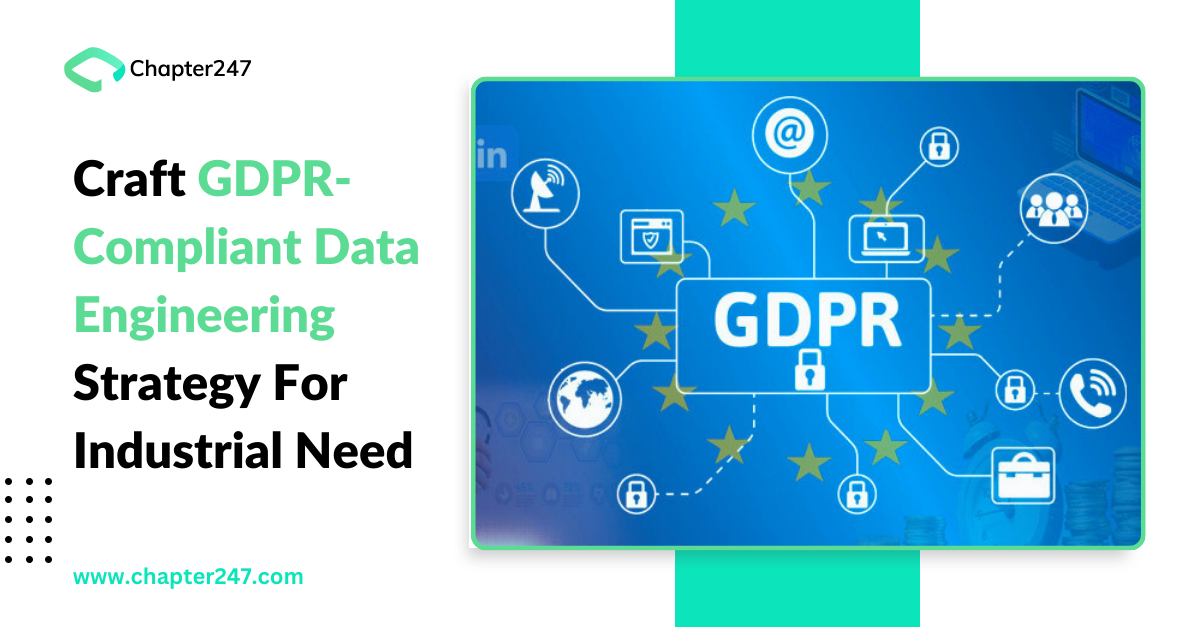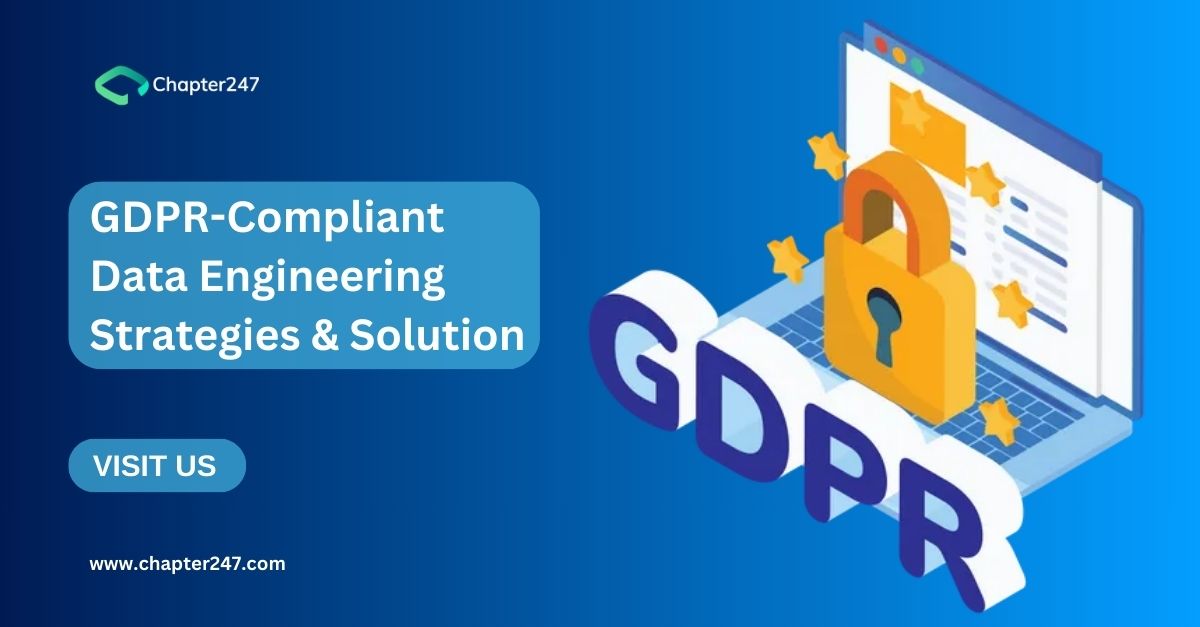From customer information to transaction records, organisations rely heavily on data to drive decision-making and operations. Being a business owner, you can agree with that. Right? However, with the growing concerns surrounding data privacy and security, what is the updated process to protect them? Don’t worry! GDPR is going to play its safe game this time.
Table Of Content
1. Let’s Have A Ride To Know About GDPR Compliance
2. Unknown Practices For Best Implementations
- Data Mapping and Inventory
- Implement Privacy by Next Level Design
- Try Data Masking and Pseudonymization
- Strengthen Data Security Measures
- Maintain Data Quality and Accuracy
- Monitor and Audit Data Processing Activities
- Get Training and Awareness
3. How Data Engineering Is Bringing Storm In GDPR Compliance
4. Conclusion
GDPR has far-reaching implications for businesses that handle personal data. This technological revolution will give them a new boost with the next level of data protection measures and ensure compliance with strict guidelines.
Several industries are also accepting things positively. Do you want to check? Hold on! According to a survey by PwC, 81% of financial services companies consider GDPR a top priority, with many investing significant resources to ensure compliance due to the sensitive nature of the data they handle.
According to a report by Deloitte, 92% of technology executives believe that GDPR will significantly impact their organisation’s data strategy and operations. Now, let’s take a deeper look at it through the following.
Let’s Have A Ride To Know About GDPR Compliance
GDPR is a comprehensive regulation designed to boost data privacy laws across different industries. Also, it empowers individuals with greater control over their data. It imposes strict requirements on how organizations collect, store, process, and handle personal data. Let’s have a quick check about the fundamental principles of GDPR, which are:
- Lawfulness, fairness, and transparency in data processing.
- Limit the collection and storage of data to only what is necessary for the intended purpose.
- Ensuring the accuracy of data and enabling individuals to rectify inaccuracies.
- Implementing appropriate security measures to protect personal data from unauthorised access, disclosure, alteration, or destruction.
- Obtaining explicit consent from individuals before processing their data.
Do you understand how it’s going to change the landscape? Exactly. With this power and fundamentals, GDPR will bring some new technological trends with the push of data engineering.
It’s going to have an impact on each industry that you can’t imagine. Just like a study by the Ponemon Institute found that 56% of healthcare organisations had experienced a data breach in the past two years. They have also highlighted the importance of strong data protection measures mandated by GDPR.
Unknown Practices For Best Implementations
To effectively implement data engineering for GDPR compliance, organisations can follow some best practices. Moreover, this is also the main matter that works as a game changer. So, let’s check that out.
Data Mapping and Inventory
Begin by conducting a thorough inventory of personal data collected and processed by any organisation. To identify potential compliance risks and vulnerabilities, map out data flow across systems, applications, and processes.
Implement Privacy by Next Level Design
Embed privacy considerations into the design and development of data systems and processes from the outset. To get extra protection, you can try a privacy-by-design that prioritises data protection and minimises the collection and processing of personal data.
Try Data Masking and Pseudonymization
To get better and more accurate results, easily implement data masking and pseudonymisation techniques. However, that will protect personal data while maintaining its usability for legitimate purposes. One can also mask sensitive information, such as social security numbers or email addresses, to prevent unauthorised access and avoid risks.
Strengthen Data Security Measures
Now, let’s introduce another one. You can now boost data security measures by implementing encryption, access controls, and authentication mechanisms. Interesting right? Secure data storage and transmission channels to prevent unauthorised disclosure or misuse of personal data.
Maintain Data Quality and Accuracy
Processes for maintaining data quality and accuracy to comply with GDPR’s requirement for ensuring the accuracy of personal data. However, it’s a crucial thing you can’t miss. Through this, one can implement data validation checks and mechanisms for individuals to update or rectify their information as needed.
Monitor and Audit Data Processing Activities
Why not try strong monitoring and auditing mechanisms to track data processing activities? Interesting right? Yes, through this, you can detect any unauthorised or non-compliant behaviour. Regularly review access logs, audit trails, and security controls to ensure compliance with GDPR requirements.
Get Training and Awareness
It’s better to get proper training than make a mistake. Keeping that in mind, educate employees about their roles and responsibilities in ensuring GDPR compliance, particularly those involved in data handling and processing activities. However, you can provide training on data protection principles, privacy regulations, and best practices for safeguarding personal data and organisations.
How Data Engineering Is Bringing Storm In GDPR Compliance
Data engineering encompasses the processes, tools, and techniques to design, build, and maintain data pipelines and infrastructure. It involves data ingestion, transformation, storage, and analysis. Different industries like telecom, real estate, EdTech, and others are also benefiting from that.
According to a survey by Capgemini, 80% of telecom companies have invested in GDPR compliance initiatives to avoid regulatory fines and protect their brand reputation. Moreover, a survey by EY found that 60% of retail and consumer product companies viewed GDPR compliance as a top priority, recognising the potential reputational and financial risks associated with non-compliance. But how are they connecting with each other?
- Data Minimisation
- Data Encryption and Anonymization
- Consent Management
- Data Governance and Auditability
- Data Subject Rights Management
Conclusion
Achieving GDPR compliance requires a concerted effort from across the organisation, with data engineering playing a pivotal role in implementing robust data protection measures and ensuring adherence to regulatory requirements. To be part of this Storm Chapter247 will open a door for you. By prioritising data privacy and adopting a proactive approach to compliance, then can help organisations build trust with their customers and stakeholders. Also, you will get assurance about long-term success with your business in an increasingly data-driven world.








